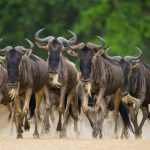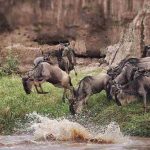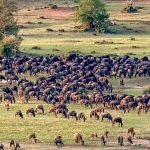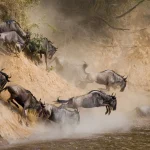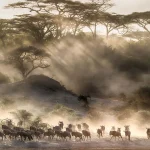Wildbeest Migration
Wildebeest Migration in Tanzania
The sweeping savannahs of the famed Serengeti offer breathtaking wildlife spectacles year-round. The herds of the dramatic Great Migration move throughout the year, congregating in the north from late June as they prepare to cross the Mara River, and in the south from late December as they give birth to the next generation. Away from the migration and its crowds, there are black rhino, cats a plenty, elephant, scavengers, and a variety of birdlife.
June & July
Why travel at this time
June is usually green and lush across most parts of the Serengeti after the season of the long rains. By the second half of the month, the dry season is already starting to take hold, improving game viewing conditions and offering value for money ahead of the approaching peak season. The migratory herds are usually still fairly spread out, some coming through the Grumeti Reserve and others through the central Serengeti as they make their way northwards.
July marks the start of peak season throughout most of the Serengeti, with game viewing conditions at their best. The herds of the Great Migration are usually at the Mara River by mid-July, with river crossings happening almost daily for the next few months as confused wildebeest cross back-and-forth through crocodile infested waters. Across all regions of the park, game viewing is particularly strong as wildlife depends on available water resources, and the thinning vegetation makes for perfect conditions. The northern Serengeti can be incredibly busy at this time of the year, making a two-centre stay advisable to fully appreciate all that the Serengeti can offer.
Highlights:
Days are dry, mild, and sunny, offering perfect safari conditions.
Photographic opportunities abound.
October to December
Why travel at this time
October is the last month of the dry season, despite the chance of afternoon showers towards the end of the month. The last of the river crossings are taking place in the northern Serengeti as the herds of the migration move southwards. By mid-November, the short rains have usually arrived, offering some relief to the dry conditions and refreshing both the wildlife and the landscape. The short afternoon showers create perfect photography conditions, dampening the dust and with moody skies as the backdrop. The wildebeest herds can be quite stretched out at this time, enjoying the abundance of grazing as they make their way south, where they will once again mass together into a mega-herd.
By mid-December the rainfall has subsided, but occasional showers may still be experienced. January brings hot, sunny, and clear days. Wildebeest calving season is happening on the nutrient-rich grasslands of the southern Serengeti, as thousands of baby wildebeest are born daily, creating a frenzy of activity for predators and scavengers.
The best safari conditions at the end of the dry season.
Calving season begins in the southern Serengeti,
bringing plenty of predator action.
February & March
Why travel at this time
February continues with hot sunny days and the occasional short shower. The southern Serengeti is a hive of activity as calving season continues to attract photographers and predators alike. In March, the afternoons begin to see gathering clouds as the rainy season approaches, eventually bursting as the rains begin. The long rains continue to mid-May, with heavy rainfall and challenging game-viewing conditions. The migration herds begin to fracture and disperse, spreading out over vast distances as they move northwards through the central Serengeti or into the Western Corridor. Many camps close during this period due to the rains, but those that remain open offer excellent rates for travellers prepared for an adventure. Very few tourists are in the Serengeti, creating a strong sense of exclusivity. By mid-May the rains are usually subsiding, leaving the landscape green and lush and the herds continue to meander northwards.
Highlights:
Photographic opportunities abound in the southern Serengeti through February and March.
The long rains create adventurous conditions with few tourists and very competitive rates.
Excellent birding to be enjoyed in the wetter conditions.
Why book with us?
Price Guarantee
At Freeingo we have wonderful relationships and connections, which enable us to give you the best prices.
Travel Tips from the Pros
We give you some expert travel advice to help make your trip smoother and more enjoyable.
Doing Good
We're committed to excellent customer service and appreciate your business.


